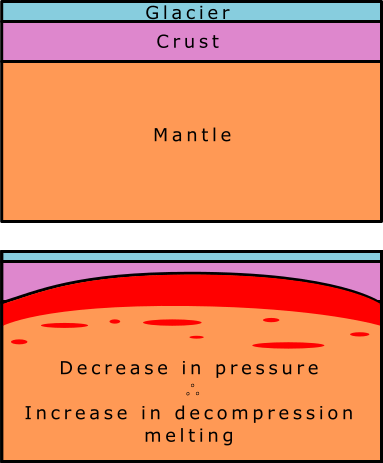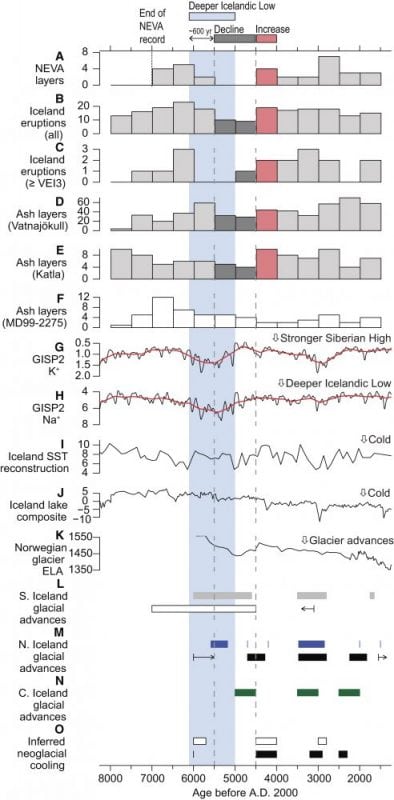
It is well known that volcanic eruptions may cause short-term and long-term changes in global climate patterns. The volcanic cloud that spread throughout the globe during the Mount Tambora eruption in 1815 (Dutch East Indies, now Indonesia) was able to partly obscure the Sun, causing a year-long global cooling that is remembered as the Year Without a Summer.
Recurring frost was reported throughout spring and summer 1816 in Massachusetts, New Hampshire, Vermont, Maine, Pennsylvania, Virginia, New York and New Jersey. On June 6, a snow blanket covered Albany, and lakes and rivers froze in August in Virginia. In Europe and Asia, heavy rainfall and unusual cold were reported as well, and in India, the monsoon was disrupted. In 1883, another great eruption, that of the Krakatoa, caused a volcanic winter, with global temperatures dropping by as much as 1.2 °C (2.2 °F) that normalized only five years later. In recent times, the eruption of Mount Pinatubo (Philippines) in 1991 cooled the globe for two years, and the volcanic ash damaged several aircraft and disrupted the air traffic for days.

Icecap retreat causes decompression of the crust and an increase in decompression melting of the mantle, making volcanic eruptions more likely.
Intense volcanism is also related to global warming due to the release of large amounts of greenhouse gases, such as CO2. Nowadays, the impact of volcanoes on the carbon cycle is very small (prof. Karen Harpp wrote in Scientific American that humans release 10,000 times more CO2 than volcanoes do!), but during the early times of our Earth, greenhouse effect due to volcanism may have been fundamental for the presence of liquid oceans and the development of life.
But here is the news: while volcanoes affect the climate, the opposite is also true. Climate change could affect the frequency of volcanic eruptions at high-latitude volcanoes, Claire Cooper from the University of Leeds, UK, says. We’re investigating the potential link between climate change and volcanism. Several previous studies have suggested that a rapid period of warming might affect the frequency of eruptions at high-latitude volcanoes, through a process known as the ‘unloading effect’.
This process, caused by the retreat of the ice cap, reduces the pressure on the crust, which rebounds and uplifts, decompressing, in turn, the mantle. In their recent papers on Earth Science Reviews and Geology, Claire and her colleagues at the University of Leeds, the University of St. Andrews, the University of Cambridge and the University of South Florida, showed that this decompression cases increased melting of the mantle, potentially making volcanic eruptions more likely, particularly in locations that already have significant volcanic activity, such as Iceland. More frequent volcanic eruptions would have significant implications in terms of direct volcanic hazards, and in terms of increased damage caused by ash clouds over Europe. For example, the eruption of the unpronounceable Eyjafjallajökull in Iceland in 2010 caused air traffic disruption over Europe and Canada, with more than 100,000 flights being canceled and an economic loss of about US$ 1.7 billion.

Correlation between climate change and volcanic activity in Iceland.
The current focus of our work — Claire says — is establishing whether such fluctuations in activity concurrent with periods of climate change can be seen in the past. Their team is looking for traces of volcanic material (tephra) in peat and lake sediments, which can even be so small that are invisible to the naked eye (cryptotephra). The chemical composition of the ash ejected during each eruption is unique, so the tephra deposits can be identified and dated consistently over a large area.
On the recently-published work on Geology, the Leeds-based team, led by Dr. Graeme Swindles, presents some recent findings in that field, suggesting that such a link can be actually seen within the past 10,000 years. Their figure shows a steady decrease in Icelandic volcanic activity from 6.2 to 5 thousand years ago, corresponding to a cooling event with the ice cap advancing and thickening, followed by a sudden increase of eruptions when the temperature rose again and the ice began melting more and more. Fascinating and terrifying, isn’t it?
In our previous posts, we showed that climate change is likely to cause more landslides, which could even enhance CO2 emissions, worsening the global warming. We’ve also shown that climate change can cause more floods and droughts, damage our sources of drinking water, alter ocean currents and ecosystems, diminish the biodiversity.
Studies showed that climate change affects every aspect of our society. Recent studies even pointed out a possible link between climate change and increased frequency of earthquakes. Climate change is unequivocal, and over 97% of the scientific work on the matter agrees that mankind is to blame for it. If you don’t think that climate change is real, it is definitely time to get informed about it, so check our climate change 101 guide here!
Claire Louise Cooper is PhD researcher at the School of Earth and Environment and the Priestley International Centre for Climate of the University of Leeds, UK, where 171 academics with expertise in Geography, Earth Sciences, Biology, Politics, Engineering, and Economics are working hard to understand climate change and its impacts on nature and society, to find suitable strategies for mitigation and adaptation. Further information on the Centre can be found here.









